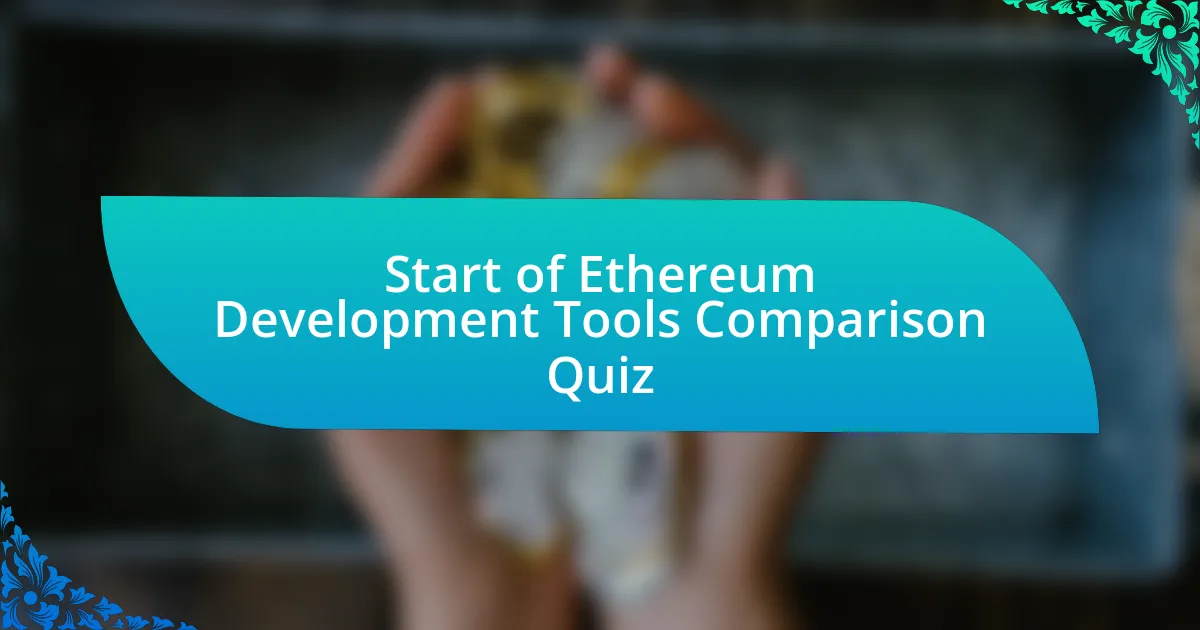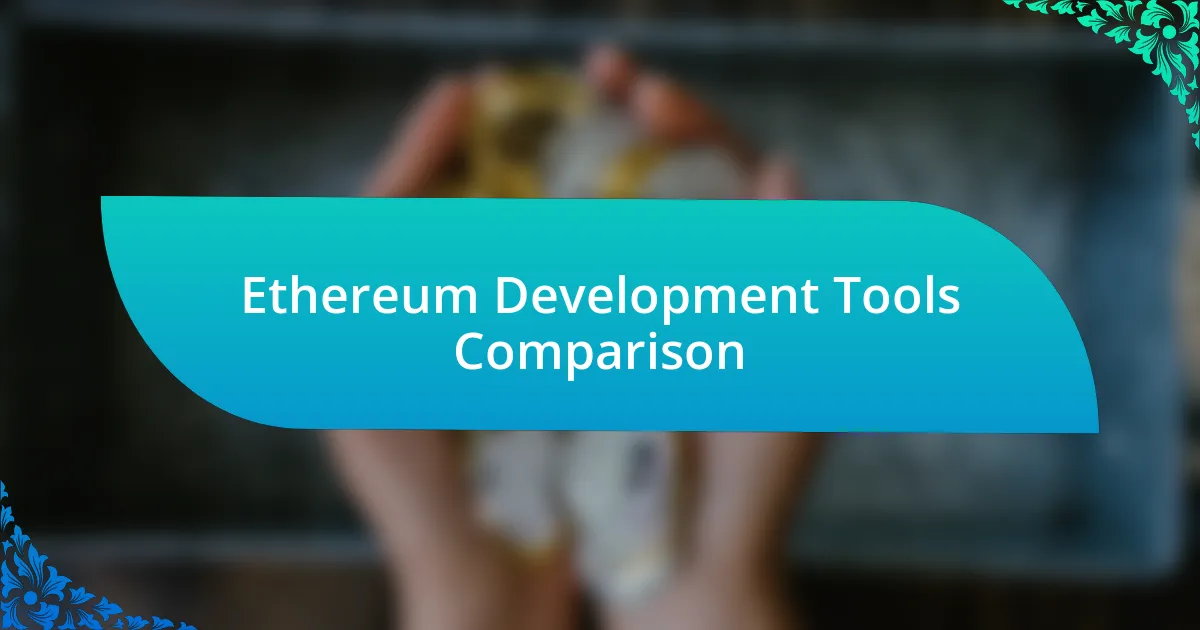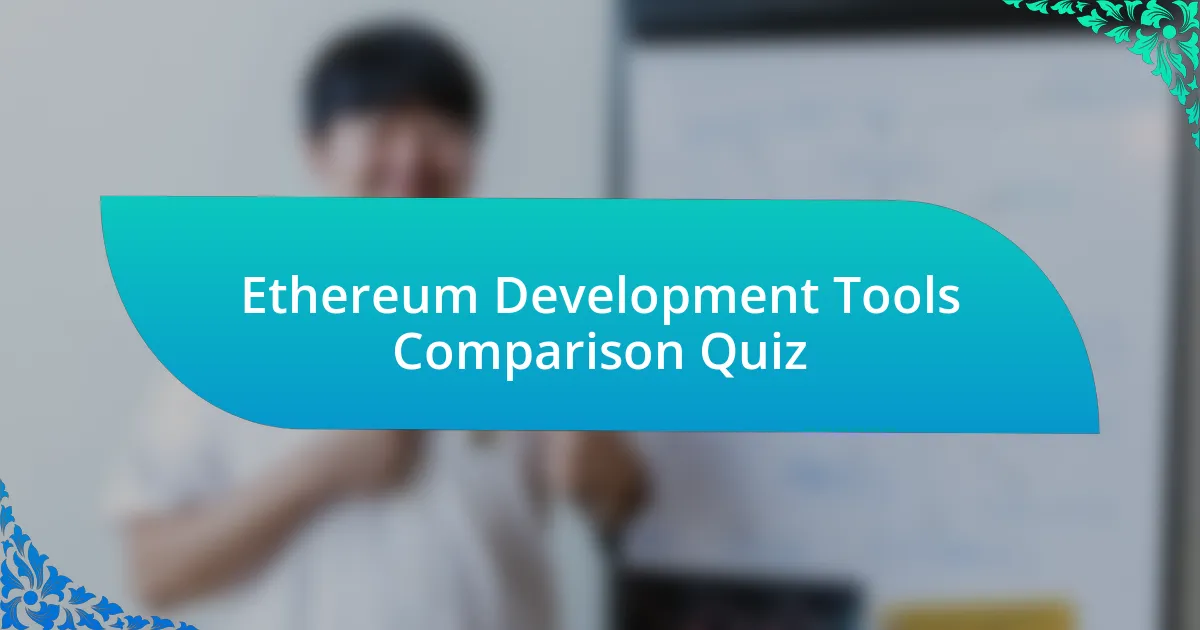
Start of Ethereum Development Tools Comparison Quiz
1. What is Truffle?
- Truffle is a gourmet chocolate brand known for its premium quality.
- Truffle is a type of expensive party decoration used in events.
- Truffle is a type of mushroom commonly found in forests.
- Truffle is a comprehensive development framework for Ethereum that simplifies the entire dApp development process.
2. What are the key features of Truffle?
- Truffle includes smart contract compilation, an integrated testing framework with Mocha and Chai, a migration system, and a built-in development console.
- Truffle comes with a native cryptocurrency wallet, allowing developers to securely store and manage their tokens seamlessly.
- Truffle provides a GUI for managing blockchain nodes and networks, making it easy to deploy contracts visually.
- Truffle offers a complete data storage solution for Ethereum transactions and user accounts, simplifying database interactions.
3. What are the advantages of using Truffle?
- Truffle combines multiple tools in one framework.
- Truffle only supports Bitcoin development.
- Truffle is a gaming platform for Ethereum.
- Truffle is only a code editor for smart contracts.
4. What are the disadvantages of using Truffle?
- Truffle can be complex for beginners and may experience performance issues with larger projects.
- Truffle is limited to only testing environments and cannot be used for deployment.
- Truffle does not support Solidity or smart contract development at all.
- Truffle requires a paid subscription for full access to features and tools.
5. What is Hardhat?
- Hardhat is a cryptocurrency used for online transactions and trading.
- Hardhat is a digital wallet for securely storing and managing cryptocurrencies.
- Hardhat is a powerful Ethereum development environment that allows developers to create, test, and deploy DApps with flexibility and robustness.
- Hardhat is a blockchain-based game platform focusing on user-generated content.
6. What are the key features of Hardhat?
- Hardhat provides a local Ethereum network, advanced debugging capabilities, a plugin system, and built-in tasks for automation.
- Hardhat offers a built-in wallet system, automated bond issuance, wide cryptocurrency trading features, and advanced gaming development tools.
- Hardhat allows for anonymous transactions, real-time monitoring of market prices, decentralized exchange features, and multi-blockchain support.
- Hardhat supports integration with traditional databases, extensive support for mobile app development, offline coding tools, and rich multimedia capabilities.
7. What are the advantages of using Hardhat?
- Hardhat is highly customizable, offers excellent debugging tools, and is actively developed with frequent updates.
- Hardhat provides a free wallet for managing cryptocurrencies and tokens.
- Hardhat is primarily designed for building mobile applications on Ethereum.
- Hardhat guarantees instant transaction finality on the Ethereum network.
8. What are the disadvantages of using Hardhat?
- Hardhat provides no testing capabilities for smart contracts.
- Hardhat is always compatible with all external tools.
- Hardhat has a steeper learning curve and potential plugin instability.
- Hardhat requires minimal configuration for projects.
9. What is Remix IDE?
- Remix IDE is a web-based integrated development environment for Solidity smart contract development.
- Remix IDE is a cryptocurrency wallet for managing digital assets.
- Remix IDE is a marketplace for buying and selling NFTs.
- Remix IDE is a blockchain network for decentralized applications.
10. What are the key features of Remix IDE?
- Remix IDE only supports smart contract development in C++.
- Remix IDE allows developers to deploy, test, and develop smart contracts quickly.
- Remix IDE is exclusively for developing decentralized storage systems.
- Remix IDE requires complex installations for efficient smart contract testing.
11. What is Ganache?
- Ganache is a programming language specifically designed for creating smart contracts.
- Ganache is a local Ethereum blockchain simulator that allows developers to test their smart contracts in a controlled environment.
- Ganache is a cryptocurrency wallet used for managing digital assets.
- Ganache is a popular consensus algorithm used in blockchain networks.
12. What are the key features of Ganache?
- Ganache offers integration with multiple deployment platforms and scalability features.
- Ganache enables the creation of decentralized applications directly without testing functionalities.
- Ganache specializes in real-time blockchain analytics and monitoring tools.
- Ganache provides a local blockchain for testing and debugging, with features like gas management and transaction simulation.
13. What is Web3.js?
- Web3.js is a JavaScript library that allows developers to interact with the Ethereum blockchain.
- Web3.js is a Python framework for data analysis.
- Web3.js is a game development platform for Unity.
- Web3.js is a mobile application for Bitcoin trading.
14. What are the key features of Web3.js?
- Web3.js enables developers to design 3D environments for games and virtual reality applications.
- Web3.js is primarily a blockchain analysis tool for tracking cryptocurrency prices and trends.
- Web3.js provides methods for interacting with the Ethereum network, including account management and contract calls.
- Web3.js helps developers create user interfaces for mobile applications and desktop software.
15. What is Ethers.js?
- Ethers.js is a hardware wallet specifically designed for securing Ethereum cryptocurrencies.
- Ethers.js is a database system for storing Ethereum transaction logs and user data.
- Ethers.js is an online marketplace for buying and selling Ethereum-based assets.
- Ethers.js is a comprehensive Ethereum library ecosystem that supports general-purpose Ethereum development, including wallet and dApp interactions.
16. What are the key features of Ethers.js?
- Ethers.js only facilitates decentralized storage usage, enabling quick data sharing.
- Ethers.js allows developers to create private Ethereum networks with enhanced security.
- Ethers.js provides exclusive support for Bitcoin transactions and wallet management.
- Ethers.js works with popular JSON wallets, connects to common Ethereum nodes, and supports various blockchain interactions.
17. What is Brownie?
- Brownie is a Python-based development framework for Ethereum that simplifies the process of creating, testing, and deploying smart contracts.
- Brownie is an app designed for tracking personal finances and budgeting.
- Brownie is a video game character popular in various role-playing games.
- Brownie is a type of chocolate dessert typically made with cocoa powder.
18. What are the key features of Brownie?
- Brownie supports Python-based smart contract development, includes automated testing, and integrates with the Ethereum Virtual Machine (EVM).
- Brownie offers a comprehensive development framework for Java-based applications focusing on traditional programming.
- Brownie includes a native debugging tool for analyzing big data transactions through visualizations.
- Brownie provides a local Ethereum network for testing and debugging smart contracts effectively.
19. What is Infura?
- Infura is a popular Ethereum wallet application for managing cryptocurrency.
- Infura is a decentralized exchange platform for trading Ethereum tokens.
- Infura is an API service that provides access to the Ethereum blockchain, allowing developers to interact with the network through JSON-RPC endpoints.
- Infura is a blockchain analytics tool that tracks Ethereum transaction data.
20. What are the key features of Infura?
- Infura allows unlimited storage for blockchain data without any limitations.
- Infura only supports transactions for Bitcoin and not Ethereum.
- Infura offers secure and reliable access to the Ethereum network, supporting various use cases including dApp development and smart contract interactions.
- Infura provides a local test network for cryptocurrency mining.
21. What is Alchemy?
- Alchemy is a modern programming language for web development.
- Alchemy is a type of ancient magic used for gold making.
- Alchemy is a platform providing tools for blockchain interaction.
- Alchemy is a social media app for sharing videos.
22. What are the key features of Alchemy?
- Alchemy offers robust APIs for interacting with the Ethereum network.
- Alchemy specializes in cloud storage solutions for data management.
- Alchemy is a blockchain game development platform.
- Alchemy provides tutorials for basic programming skills.
23. What is The Graph?
- The Graph is a decentralized protocol for indexing and querying blockchain data.
- The Graph is a smart contract development tool for Ethereum.
- The Graph is a framework for building decentralized applications.
- The Graph is a cryptocurrency exchange platform.
24. What are the key features of The Graph?
- The Graph helps in mining Ethereum efficiently.
- The Graph provides decentralized indexing and querying services.
- The Graph manages blockchain transactions for users.
- The Graph is a blockchain that stores user data securely.
25. What is Casper Labs?
- Casper Labs is a financial services company providing loans.
- Casper Labs is a smart contract platform for developers.
- Casper Labs is a game development studio focused on mobile games.
- Casper Labs is a social media network aimed at teenagers.
26. What are the key features of Casper Labs?
- Casper Labs offers a custom hardware solution for mining.
- Casper Labs operates exclusively on the Bitcoin blockchain.
- Casper Labs includes software development kits and documentation.
- Casper Labs excludes developer tools and libraries.
27. What is Kaleido?
- Kaleido is a cryptocurrency exchange focused on trading NFTs and digital assets.
- Kaleido is a virtual reality game that allows players to build custom worlds and share them online.
- Kaleido is a social media platform designed for artists to showcase their work and connect with audiences.
- Kaleido is a platform that simplifies the process of building, testing, and deploying smart contracts on various blockchains, offering pre-built templates and automated deployment tools.
28. What are the key features of Kaleido?
- Kaleido is a JavaScript library for interacting with blockchain networks.
- Kaleido integrates different Ethereum tools for a comprehensive development experience.
- Kaleido provides pre-built smart contract templates, tools for testing smart contract functionality, automated deployment, and contract management features.
- Kaleido offers a local blockchain simulator for testing and debugging smart contracts.
29. What is Vyper?
- Vyper is a wallet application for managing Ethereum assets.
- Vyper is a Python-based smart contract language compatible with the EVM.
- Vyper is a Java-based blockchain platform for dApps.
- Vyper is a decentralized exchange for trading cryptocurrencies.
30. What are the key features of Vyper?
- Vyper supports Python-based smart contract development, reduces software faults, and simplifies auditing smart contracts.
- Vyper integrates artificial intelligence for automated smart contract creation.
- Vyper offers advanced user interface design tools for decentralized applications.
- Vyper enables graphics programming for contract visualization and management.

Quiz Completed Successfully!
Congratulations on finishing the quiz on Ethereum Development Tools Comparison! We hope you found the experience enjoyable and enlightening. Testing your knowledge not only reinforces your understanding but can also reveal new insights into the rich ecosystem of Ethereum development tools.
Throughout this quiz, you may have discovered various tools used for smart contract development, testing, and deployment. Understanding the differences between tools like Truffle, Hardhat, and Ganache is crucial for efficient development. Each tool has unique features that cater to different aspects of the development process, and recognizing these can significantly enhance your Ethereum projects.
We invite you to dive deeper into this subject by checking the next section on this page. It offers a more comprehensive overview of Ethereum development tools. Expanding your knowledge on these tools will empower you in your development journey. Happy learning!

Ethereum Development Tools Comparison
Overview of Ethereum Development Tools
Ethereum development tools facilitate the creation and management of decentralized applications (dApps) on the Ethereum blockchain. These tools streamline tasks such as coding smart contracts, deploying applications, and managing blockchain interactions. Popular tools include Integrated Development Environments (IDEs), testing frameworks, and libraries. Each tool serves distinct purposes, enhancing productivity and efficiency in the development process.
Key Categories of Ethereum Development Tools
Ethereum development tools can be categorized into several key areas. These include programming languages, development frameworks, testing tools, and deployment platforms. Solidity is the primary programming language for Ethereum smart contracts. Frameworks like Truffle and Hardhat simplify development and testing. For testing, tools such as Ganache and Waffle are widely used. Deployment options like Infura make it easier to launch applications on the Ethereum network.
Popular Ethereum Development Frameworks
Ethereum development frameworks provide structured environments for building dApps. Truffle, a widely-used framework, offers tools for compiling, deploying, and linking smart contracts. Hardhat is another powerful framework that promotes local development and testing. Both frameworks support plugins, enhancing functionality. Developers often choose frameworks based on team preferences and project requirements.
Testing Tools for Ethereum Development
Testing is critical in Ethereum development to ensure smart contracts function correctly. Tools like Ganache create a personal blockchain for testing purposes. They allow developers to run tests in a controlled environment. Waffle and Mocha are additional frameworks that facilitate unit testing of smart contracts. These testing tools help identify bugs early, minimizing risks upon deployment.
Deployment Solutions for Ethereum Applications
Deployment solutions streamline the process of launching Ethereum applications onto the network. Services like Infura allow developers to connect to Ethereum without hosting a node. This reduces infrastructure complexity. On the other hand, platforms like Alchemy offer enhanced monitoring and analytics for deployed dApps. Choosing a deployment solution depends on scalability needs and operational preferences.
What are the main Ethereum development tools?
The main Ethereum development tools include Truffle, Hardhat, Remix, Ganache, and Infura. These tools facilitate smart contract development, testing, and deployment on the Ethereum blockchain. For instance, Truffle provides a suite of tools for writing, testing, and deploying smart contracts, while Remix is a browser-based IDE that allows for quick testing and debugging.
How do Ethereum development tools differ from each other?
Ethereum development tools differ in functionality and user interface. Truffle is geared towards a comprehensive development framework, supporting scripting and automated testing. Hardhat, on the other hand, focuses more on a flexible environment suited for complex projects, allowing for advanced debugging. Remix provides a simpler, more accessible interface for beginners, emphasizing ease of use over extensive features.
Where can developers access Ethereum development tools?
Developers can access Ethereum development tools primarily online. Tools like Truffle, Hardhat, and Remix have official websites where they can be downloaded or accessed directly. Additionally, platforms like GitHub host these tools, allowing for community contributions and updates. Many tools also have integrated documentation readily available for ease of learning.
When is it advisable to use specific Ethereum development tools?
It is advisable to use specific Ethereum development tools based on project requirements. For rapid prototyping or small projects, Remix is an ideal choice due to its user-friendly interface. For larger projects requiring extensive testing and deployment, Truffle or Hardhat is recommended as they offer comprehensive functionalities to manage complex contracts efficiently.
Who commonly uses Ethereum development tools?
Ethereum development tools are commonly used by blockchain developers, including individual freelancers, startups, and established companies working on decentralized applications (dApps). Additionally, educators and students in blockchain courses utilize these tools to learn Ethereum smart contract development, enhancing practical skills in a growing field.

